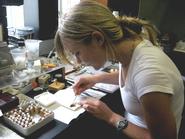
Cuttlefish, dogfish, and puffer-fish are not common household pets, but Genevieve Flanders '09 is getting up-close and personal with them this summer. She is spending the summer as an intern at the Woods Hole Marine Biological Laboratory (MBL) in Massachusetts where she works with those as well as Hermissenda crassicornis sea slugs.
Flanders was one of more than 20 Hamiltonians who received college funding to participate in a summer internship. Work experience is becoming more and more necessary for college students but many opportunities are unpaid and require students to pay their own housing and living expenses as well as working for free.
Thanks to alumni and parent donations, Hamilton students can apply for funding to support them while they work in a field of interest with an organization that cannot pay them. Though Flanders works in an unpaid internship, she received a stipend from Hamilton's Joseph F. Anderson Internship Fund, given in honor of a 1944 Hamilton graduate who served the college for 18 years as vice president for communications and development. The fund in his name provides individual stipends to support full-time internships for students wishing to expand their educational horizons in preparation for potential careers after graduation.
The slug Hermissenda is a long-standing lab subject for learning and memory, with understandable neurophysiological processes which have proved to be compatible with the learning processes in higher vertebrates. MBL scientist Dr. Alan Kuzirian is interested in the effects on the sea slugs of the cancer drug bryostatin, which enhances their memory drastically. Flanders works with Kuzirian and another intern, researching learning proteins produced by Hermissenda. The lab team hopes that their research may generate a treatment for Alzheimer's disease.
They train the slugs to respond to light by curling up, and then dissect the animals to analyze the nervous system. The research team also treats the slugs with inhibitors for different proteins and enzymes that are associated with learning, testing how much protein is produced by the learning process and where it originates. "The main goal of the summer is to find the relationship between three proteins found in neurons: PKC, PKA and CREB," Flanders explained. Then she added, "hopefully we'll be able to publish."
Flanders, who applied for the position with the MBL because she wanted more experience in lab research, went straight for Kuzirian's project because of its enticing combination of biophysics, molecular and cellular biology, and morphology. "It sounded perfect to me." And although she faces a commute of more than an hour each day from her home in Chilmark, Mass., it is worth it. "Every day is still exciting because everything we do can lead to a new discovery. It's a great opportunity to learn what a career in science is like," Flanders said. She enjoys the hands-on work in the lab, spending time with her fellow interns in the lively summer community that gathers around Woods Hole, and working with Kuzirian, who "has an uncanny resemblance to Albert Einstein."
On the Hill she is on the women's cross-country and track teams and plays IM soccer and ice hockey as well as being active in several of Hamilton's volunteer and service organizations. Flanders is a neuroscience major who hopes to work in neurobiological research after she graduates. "I guess the exposure is one of the main points of an internship," she mused. "I picture myself going to a job like this when I am older."
-- by Lisbeth Redfield
Posted July 17, 2007
